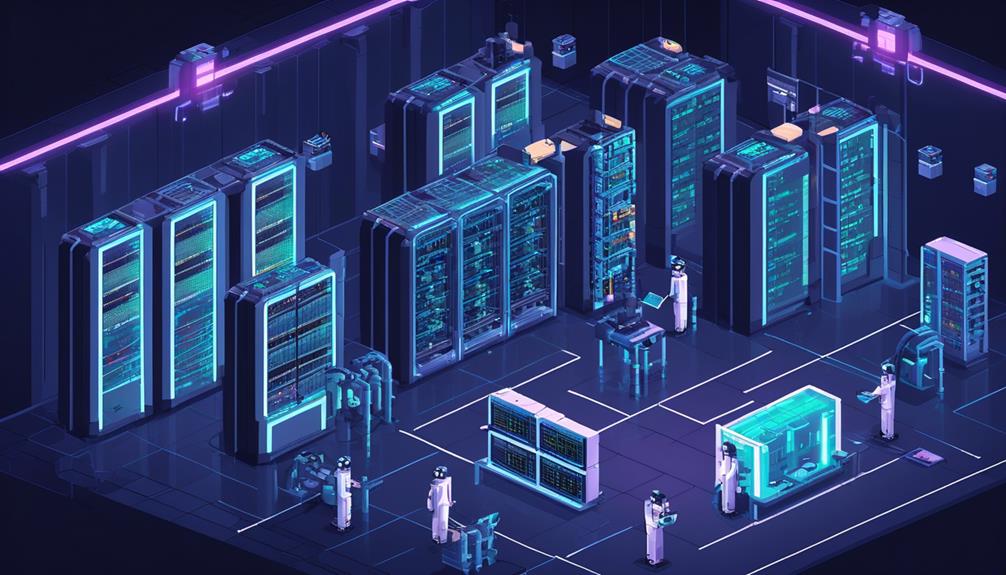Artificial Intelligence (AI) has emerged as a transformative technology in various industries, and data centers are no exception. As the demand for processing power, storage, and data management continues to increase, organizations are turning to AI to optimize their data center operations.
The introduction of AI in data centers brings numerous benefits, including improved workload management, enhanced resource utilization, and increased business continuity.
In this discussion, we will explore the key aspects and applications of AI in data centers, delving into topics such as AI-optimized hardware solutions, emerging technologies, and considerations for deploying AI workloads.
So, let's dive into the fascinating world of AI in data centers and discover how this technology is revolutionizing the way organizations manage and operate their critical infrastructure.
Key Takeaways
- Integration of high-performance servers, storage systems, and networking infrastructure is crucial for AI deployment in data centers.
- Specialized hardware accelerators like GPUs and FPGAs play a significant role in improving AI performance in data centers.
- AI algorithms and analytics enable optimization of resource management, data analysis, and enhanced security in data centers.
- Proactive workload management, predictive maintenance, and real-time dynamic resource allocation are essential for efficient AI application development and execution in data centers.
AI in Data Center Infrastructure
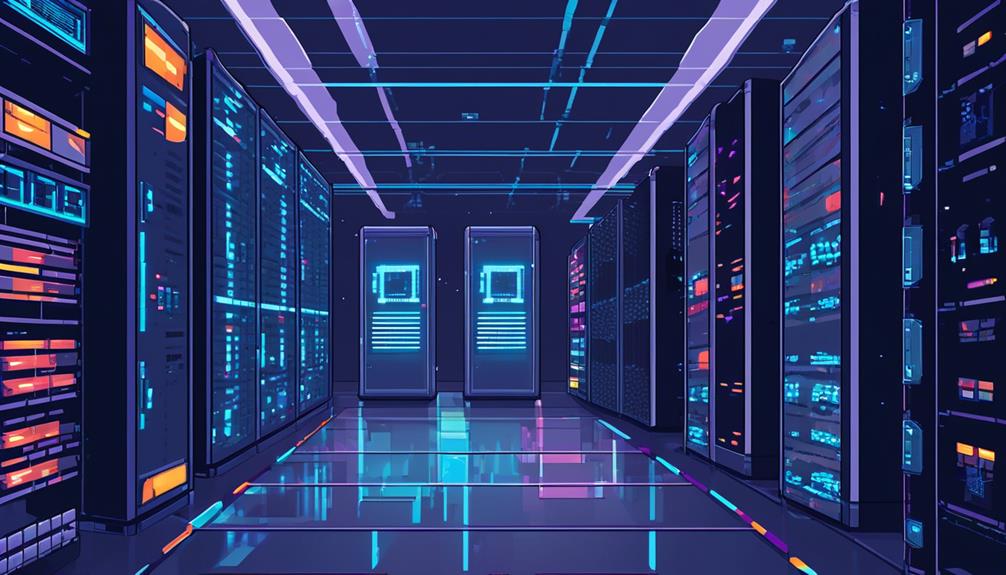
AI in Data Center Infrastructure involves the integration of high-performance servers, storage systems, and networking infrastructure with specialized hardware accelerators to support the development and execution of AI applications at scale. Data centers are critical for AI support, providing the computational power and storage capacity needed to handle the immense processing demands of AI workloads.
To effectively deploy AI in data centers, infrastructure provisioning becomes crucial. High-performance servers are essential for handling the complex calculations required for AI algorithms. These servers are equipped with powerful processors and large amounts of memory to handle the massive data sets involved in AI applications.
Storage systems are another important component, as they provide the necessary capacity to store and retrieve the vast amounts of data required for AI training and inference.
Networking infrastructure plays a vital role in connecting the various components within a data center and ensuring efficient communication between them. This infrastructure needs to be robust and scalable to handle the increased data traffic generated by AI workloads.
Additionally, specialized hardware accelerators, such as graphics processing units (GPUs) or field-programmable gate arrays (FPGAs), are often incorporated to enhance the performance of AI applications. These accelerators are specifically designed to handle the parallel processing required by AI algorithms, enabling faster and more efficient execution.
Power and cooling considerations are also crucial in AI data center infrastructure. AI workloads can be extremely resource-intensive, leading to increased power consumption and heat generation. Data centers need to be equipped with efficient power delivery systems and cooling mechanisms to ensure optimal performance and prevent system failures.
Transforming Data Center Operations
The integration of artificial intelligence (AI) technologies has the potential to revolutionize data center operations, enhancing efficiency, productivity, and security.
AI algorithms and machine learning techniques can optimize resource management within data centers, ensuring that computational power, storage, and network bandwidth are efficiently allocated to meet the demands of various workloads. By analyzing historical data and real-time metrics, AI can dynamically adjust resource allocation, leading to improved performance and reduced energy consumption.
Data centers can also benefit from AI in terms of data analysis and insights. AI-powered analytics can process vast amounts of data generated within the data center, extracting valuable information that can be used for capacity planning, predictive maintenance, and troubleshooting. This enables data center operators to proactively address potential issues before they impact operations, reducing downtime and improving overall reliability.
Furthermore, AI can enhance data center security by continuously monitoring network traffic, access logs, and system behavior for anomalies. It can detect and alert administrators about potential threats, such as unauthorized access attempts or suspicious activities, enabling prompt response and mitigation.
To effectively leverage AI in data center operations, organizations need to consider the underlying architectures. NVIDIA, a leading provider of AI computing platforms, offers solutions specifically designed for AI data centers. These architectures combine high-performance GPUs with specialized software frameworks, enabling efficient AI training and inference tasks.
In addition, advancements in networking technologies like InfiniBand play a crucial role in supporting AI workloads in data centers. InfiniBand's high-speed and low-latency capabilities enable fast data transfers between compute nodes, improving the performance of AI training and data analysis.
Ai-Optimized Hardware Solutions
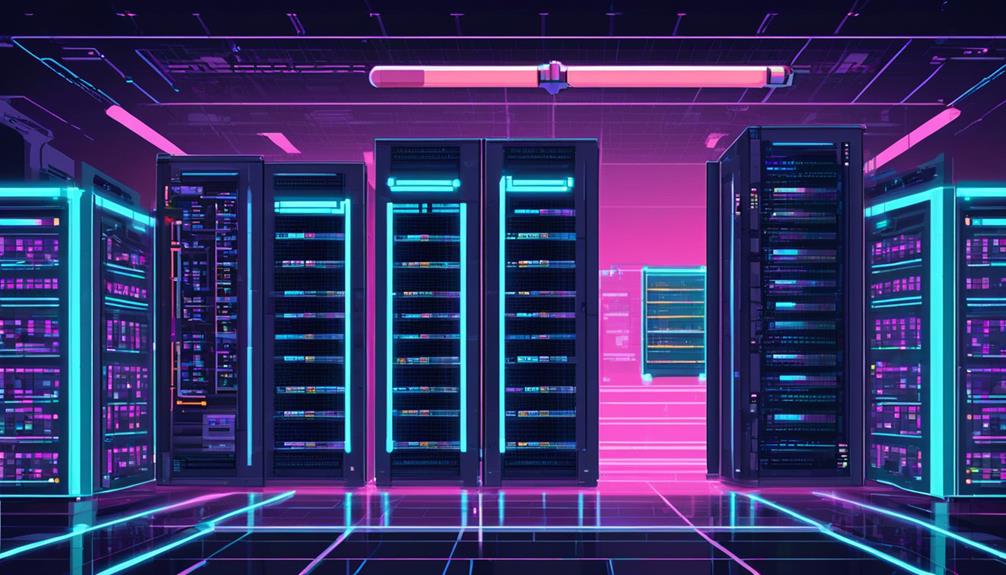
As data centers continue to evolve and incorporate AI technologies, one crucial aspect to consider is the implementation of AI-optimized hardware solutions. These solutions are specifically designed to support the computational power and low-latency networking requirements of AI workloads. By leveraging AI-optimized hardware, data centers can unlock the full potential of AI technology and enable the development and deployment of AI applications at scale.
AI-optimized hardware solutions consist of high-performance servers, storage systems, networking infrastructure, and specialized hardware accelerators. These components work together to support complex machine learning algorithms and facilitate AI application development and execution. The table below provides an overview of the key components of AI-optimized hardware solutions:
| Component | Description |
|---|---|
| High-performance servers | Powerful servers with advanced processing capabilities to handle the computational demands of AI workloads. |
| Storage systems | Scalable and high-capacity storage solutions to store and retrieve large datasets used in AI training and inference. |
| Networking infrastructure | Low-latency networking infrastructure to ensure fast and efficient communication between AI components and data sources. |
| Specialized hardware accelerators | Dedicated hardware accelerators, such as GPUs or TPUs, designed to accelerate AI computations and improve performance. |
Improving Workload Management
Implementing proactive workload management strategies can significantly improve resource allocation and utilization in data centers. By leveraging AI, data centers can optimize their workload management and allocation processes, leading to more efficient utilization of hardware and network services.
AI workloads typically involve massive data processing and complex machine learning algorithms. With AI technologies in place, data centers can handle these workloads more effectively, ensuring optimal resource utilization and minimizing bottlenecks. Dynamic workload management powered by AI enables data centers to allocate resources based on real-time demands, enhancing service quality and reducing operational costs.
One key benefit of AI in workload management is predictive maintenance. Through AI-driven analytics, data centers can accurately predict hardware failures or performance degradation, allowing for timely maintenance and minimizing downtime. This proactive approach not only improves workload management but also reduces the costs associated with hardware replacement.
Moreover, AI can provide valuable insights into workload patterns and trends, enabling data centers to make informed decisions on resource allocation and capacity planning. By analyzing historical data and considering factors such as workload peaks and troughs, AI algorithms can optimize resource allocation and prevent over-provisioning or underutilization.
Ensuring Business Continuity
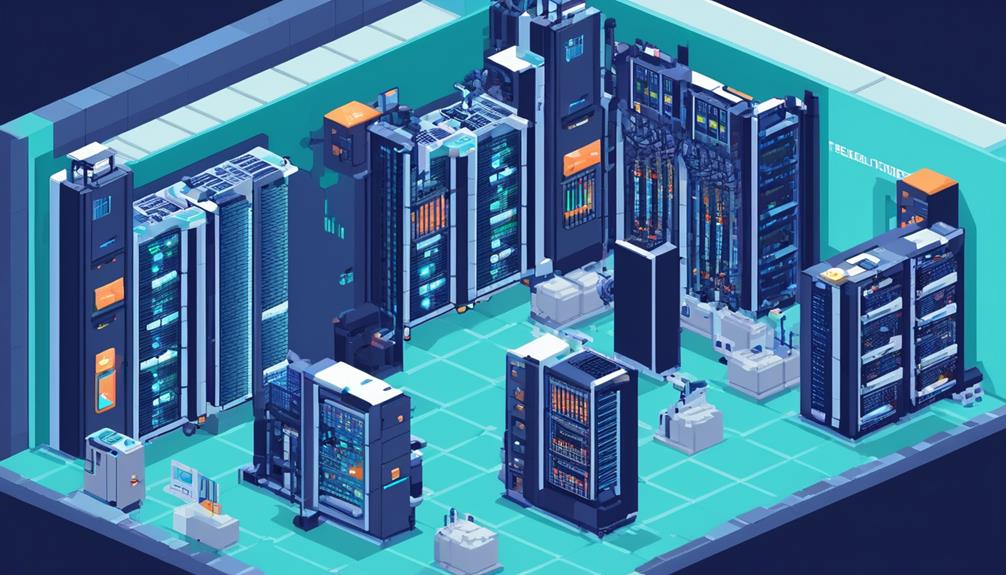
Ensuring business continuity in data centers is essential for maintaining operations and minimizing downtime risks. Resilience through automation allows for efficient and reliable management of critical processes, ensuring uninterrupted services.
Additionally, predictive maintenance benefits enable proactive identification and resolution of potential issues before they impact operations, further enhancing business continuity efforts.
Resilience Through Automation
Resilience through automation in data centers plays a crucial role in ensuring uninterrupted business continuity. By automating processes, businesses can maintain service availability and minimize downtime during unexpected events. Automation enables quick response to incidents, ensuring seamless operations and reducing the impact of disruptions.
It also optimizes resource usage and improves overall efficiency, enabling businesses to do more with their existing infrastructure. In the data center industry, advancements in technologies like NVIDIA and InfiniBand field have further enhanced automation capabilities.
AI in the data center enables intelligent automation, allowing for proactive detection and resolution of issues. Through AI-powered automation, businesses can increase their resilience, recover from failures more efficiently, and adapt to changing conditions, ultimately ensuring uninterrupted business continuity.
Predictive Maintenance Benefits
Predictive maintenance plays a critical role in ensuring uninterrupted business continuity by preventing unexpected equipment failures. By leveraging Artificial Intelligence (AI) and machine learning, organizations can identify and address potential issues before they lead to costly downtime or disruptions. The benefits of predictive maintenance in data centers are numerous.
- Improved operational efficiency: Predictive maintenance allows for the optimization of maintenance schedules and resources, leading to more efficient operations.
- Reduced maintenance costs: By addressing issues proactively, organizations can avoid expensive emergency repairs and minimize overall maintenance expenses.
- Increased equipment reliability: Implementing predictive maintenance practices can lead to improved equipment reliability, reducing the risk of unexpected failures and downtime.
- Longer asset lifespans: By identifying and addressing potential issues early on, organizations can extend the lifespan of their equipment, maximizing their return on investment.
Minimizing Downtime Risks
To ensure uninterrupted business operations, minimizing downtime risks is crucial for maintaining business continuity in data centers. One way to achieve this is by implementing robust backup and disaster recovery plans. These plans involve regularly testing and validating backup systems and procedures to ensure their effectiveness.
Additionally, employing redundant hardware and infrastructure components can help mitigate the impact of potential failures. Real-time monitoring and alerting systems play a crucial role in identifying and addressing issues before they lead to downtime. High availability solutions, such as load balancing and failover mechanisms, can also minimize the impact of system failures.
Furthermore, the use of advanced technologies like Deep Learning and Machine Learning can enhance predictive maintenance capabilities and further reduce downtime risks. Finally, data centers can leverage liquid cooling technologies to maintain optimal temperatures and prevent equipment failures.
Enhancing Customer Experience
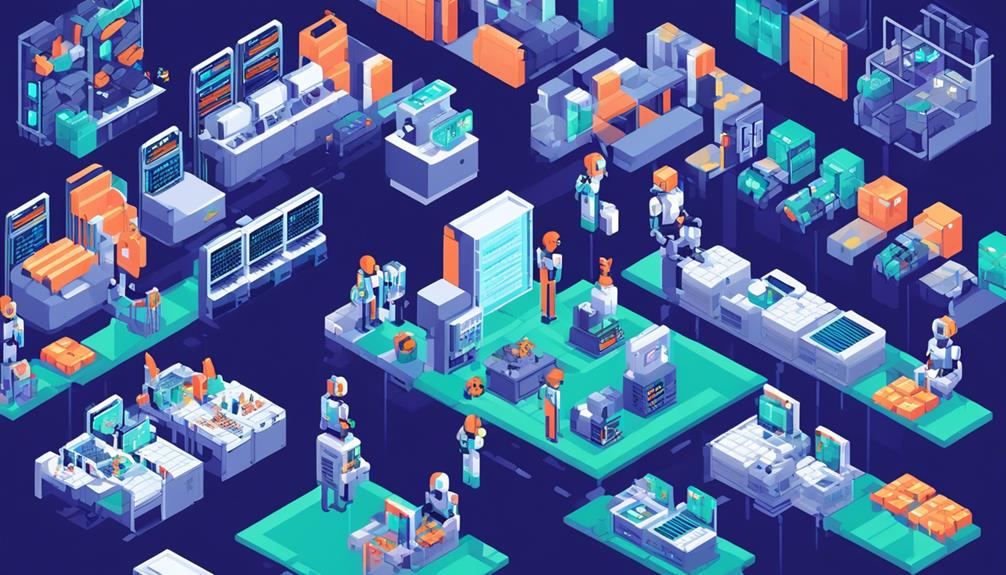
Utilizing AI in data centers can significantly enhance the customer experience by improving efficiency, productivity, and resource allocation. The implementation of AI enables enhanced data analysis, faster decision-making, and automation of repetitive tasks, leading to increased accuracy and precision. This translates to a more streamlined and seamless experience for customers when interacting with data center services.
To further emphasize the benefits of AI in enhancing the customer experience, the following bullet points highlight key aspects:
- Improved Efficiency: AI algorithms can optimize resource allocation, ensuring that customer requests are handled promptly and efficiently. This reduces waiting times and enhances overall satisfaction.
- Enhanced Productivity: By automating repetitive tasks, AI frees up human resources to focus on more complex and value-added activities. This leads to faster response times and better customer support.
- Personalized Service: AI-powered analytics can analyze vast amounts of customer data, enabling data centers to offer personalized recommendations, tailored solutions, and targeted advertisements. This enhances customer engagement and loyalty.
- Proactive Issue Resolution: AI can detect and predict potential issues before they occur, allowing data centers to take proactive measures to prevent service disruptions. This minimizes downtime and ensures a smooth customer experience.
Ai-Driven Data Center Security
AI-driven data center security utilizes artificial intelligence algorithms and techniques to enhance proactive security measures, effectively detecting anomalies in network traffic and system behavior. By leveraging AI, data centers can take the initiative against evolving cyber threats, protecting business-critical uptime and the integrity of data. AI algorithms and techniques improve data processing, storage, and security in data centers, shaping the future of the industry. To provide effective, secure, and efficient services, data centers need AI systems that optimize resource allocation, enhance data analysis, and automate repetitive tasks, thereby improving operational efficiency.
One prominent player in the AI-driven data center security space is NVIDIA, a leading technology company specializing in AI computing. NVIDIA's GPU technology powers AI applications, enabling data centers to efficiently process and analyze vast amounts of data for security purposes. In addition to its GPU technology, NVIDIA also offers the NVIDIA Mellanox networking solutions, which provide high-performance, low-latency connectivity for data centers. These solutions play a crucial role in securing data center networks, ensuring fast and secure communication between servers and devices.
To further illustrate the impact of AI-driven data center security, the following table highlights key benefits and applications:
| Benefits | Applications |
|---|---|
| Proactive threat detection | Intrusion detection systems |
| Enhanced network monitoring | Security information and event management |
| Real-time anomaly detection | Malware detection and prevention |
| Automated incident response | Access control and authentication |
The Future of Data Centers
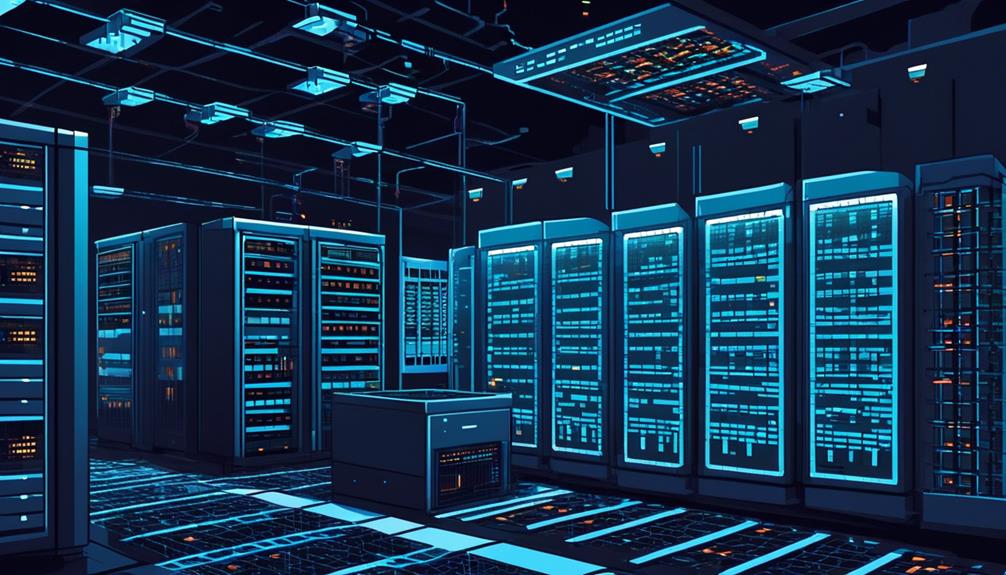
The future of data centers is being transformed by advancements in artificial intelligence (AI), revolutionizing operations, security measures, and resource management. AI is shaping the way data centers operate, providing computational power and storage capacity for AI workloads. This support is crucial for training and deploying complex AI models.
To accommodate the demands of high-performance computing (HPC) and AI workloads, data centers require high-density colocation configurations. These configurations come with extensive cooling and power requirements to maintain optimal performance. GPUs, such as those offered by NVIDIA, play a vital role in accelerating AI workloads through parallel processing. They require efficient cooling solutions to ensure peak performance.
The storage and networking infrastructure in data centers are also undergoing significant changes due to AI. AI workloads rely on large amounts of data for training and inference, necessitating high-performance storage solutions. Additionally, distributed, high-speed, low-latency networks like InfiniBand are essential to handle the massive data transfer requirements of AI workloads.
Reshaping the Data Center Industry
Advancements in artificial intelligence (AI) are causing significant shifts in the data center industry, resulting in a major reshaping of operations, security measures, and resource management. AI technologies are being implemented in data centers to optimize resource allocation, enhance data analysis, and automate repetitive tasks. This integration of AI is predicted to cost $76 billion by 2028, emphasizing the need for efficient data center management.
To highlight the impact of AI in data centers, let us consider the following table:
| AI Benefits in Data Centers | Impact |
|---|---|
| Resource Allocation Optimization | Efficiently allocate computing power and storage |
| Enhanced Data Analysis | Extract valuable insights from large datasets |
| Automation of Repetitive Tasks | Increase operational efficiency and reduce human errors |
| Improved Security Measures | Detect anomalies, predict threats, and enhance data security |
| Cost Reduction | Optimize energy consumption and lower operational costs |
AI implementation in data centers has revolutionized security measures. By leveraging AI, data centers can detect anomalies, predict threats, and improve data processing and storage. This not only ensures protection against malicious activities but also enhances overall data center security.
Looking into the future, the data center industry is expected to continually evolve with the integration of AI technologies. This evolution will focus on enhancing efficiency, adopting edge computing for AI workloads, and further improving resource management.
Managing Resources With AI
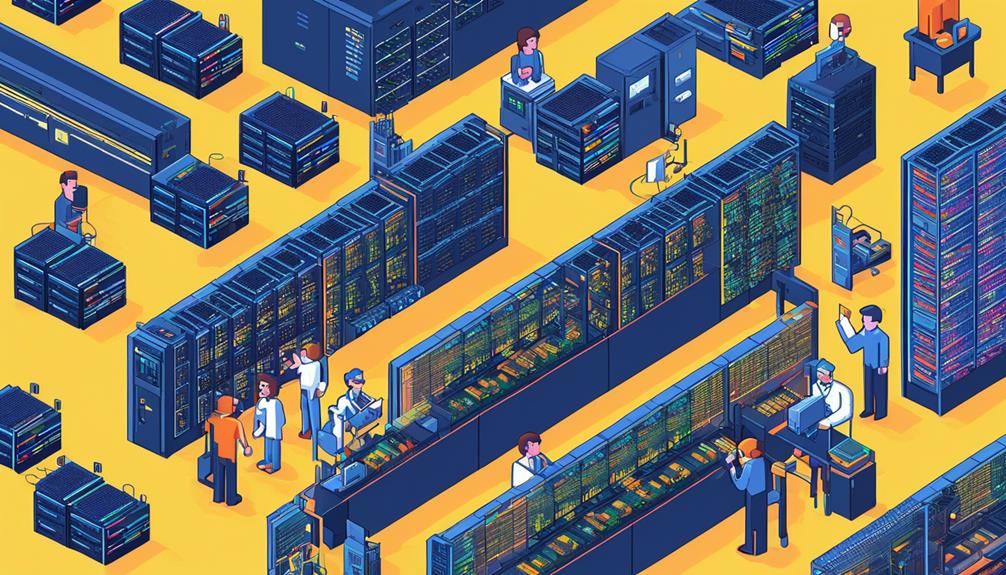
Managing resources with AI is crucial for optimizing data center operations. Resource optimization techniques, such as AI-powered energy management, enable data centers to reduce costs and improve energy efficiency by optimizing cooling systems.
Additionally, automated workload allocation ensures that hardware and network services are utilized efficiently, improving workload management and allocation.
Resource Optimization Techniques
Using AI, data centers can employ resource optimization techniques to efficiently manage and allocate workloads, improving hardware and network service utilization. This can lead to cost savings and improved performance in data center operations. Resource optimization techniques include predictive maintenance, dynamic workload management, data center cooling system optimization, and enhanced security measures.
Predictive maintenance utilizes AI algorithms to analyze data from sensors and detect potential hardware failures before they occur. This reduces downtime and hardware replacement costs.
Dynamic workload management dynamically distributes workloads across available resources, ensuring optimal service quality and reducing costs.
Data center cooling system optimization uses AI to analyze temperature and energy consumption data, enabling more efficient cooling and reducing energy costs.
Enhanced security measures involve using AI to detect anomalies in network traffic, access logs, and system behavior, enhancing data center security.
Ai-Powered Energy Management
With the implementation of AI-powered energy management, data centers can further optimize resource allocation and energy consumption, thereby enhancing operational efficiency and sustainability. AI algorithms play a crucial role in predicting and managing power and cooling requirements based on real-time data and workload patterns. By analyzing historical data and performance metrics, AI can optimize resource allocation and automate repetitive tasks in energy management. This not only contributes to reducing operational costs but also improves energy efficiency in data center operations. AI-powered energy management enables data centers to handle the increasing demands of AI workloads while maintaining efficiency and sustainability. The following table highlights the key benefits of AI-powered energy management in data centers:
| Benefits | Description |
|---|---|
| Optimized resource allocation | AI algorithms analyze data to allocate resources efficiently, reducing wastage and costs. |
| Enhanced energy consumption | AI algorithms optimize energy consumption based on real-time data and workload patterns. |
| Improved operational efficiency | Automation of energy management tasks leads to increased efficiency and reduced manual effort. |
Automated Workload Allocation
Automated workload allocation leverages the power of AI to efficiently assign resources to tasks within data centers, optimizing resource utilization and enhancing overall efficiency. This AI-driven workload management enables dynamic resource allocation based on demand and priorities, reducing manual intervention and improving overall data center performance.
With the help of AI algorithms, workload patterns can be predicted and resource allocation can be adjusted in real-time, ensuring optimal utilization of resources. This automation not only increases efficiency but also saves time and reduces the risk of human errors.
Companies like NVIDIA and InfiniBand are developing AI-powered solutions that can intelligently allocate workloads, ensuring that data centers operate at their highest potential. By harnessing the capabilities of AI, automated workload allocation is revolutionizing data center management and taking efficiency to new heights.
AI and Emerging Technologies in Data Centers
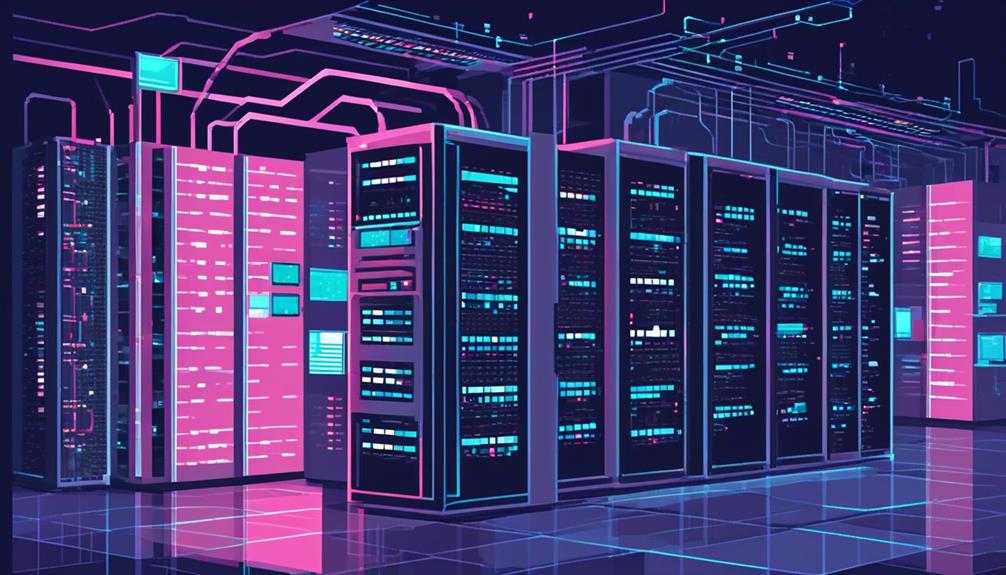
AI and emerging technologies are revolutionizing the way data centers operate and are shaping the future of this critical infrastructure. The implementation of AI in data centers enables enhanced efficiency and productivity, improved data analysis and insights, and faster decision-making processes. It optimizes resource management, enhances security, and supports the training and deployment of complex AI models. Furthermore, emerging technologies such as NVIDIA GPUs and InfiniBand networking are playing a key role in advancing the capabilities of data centers.
To better understand the impact of AI and emerging technologies in data centers, let's take a look at the following table:
| Technology | Benefits | Use Cases |
|---|---|---|
| NVIDIA GPUs | Accelerated processing power | Deep learning, AI model training |
| InfiniBand | High-speed data transfer | Big data analytics, real-time processing |
| Quantum Computing | Breakthrough computational power | Advanced simulations, cryptography, optimization |
NVIDIA GPUs, renowned for their accelerated processing power, are instrumental in supporting deep learning and AI model training within data centers. They significantly speed up the training processes and enable the development of more complex and accurate models.
InfiniBand, a high-speed data transfer technology, facilitates the seamless transfer of large volumes of data in real-time. This is particularly beneficial for data-intensive applications such as big data analytics and real-time processing.
Looking towards the future, quantum computing is expected to have a profound impact on data centers. With its breakthrough computational power, it will enable advanced simulations, cryptography, and optimization, taking data center capabilities to a whole new level.
Supporting AI With High-Performance Computing
High-performance computing (HPC) plays a crucial role in supporting AI workloads in data centers. Power requirements for AI, scalability, and AI performance are key points to consider in this context.
HPC infrastructure, including high-performance servers, storage systems, and networking infrastructure, along with specialized hardware accelerators, enable the development and execution of AI applications at scale.
Power Requirements for AI
Specialized hardware and infrastructure are necessary to meet the power requirements of supporting AI workloads in high-performance computing environments.
Data centers must have the capability to accommodate the power and cooling needs of GPUs, such as those from NVIDIA, which are essential for accelerating AI workloads.
Additionally, AI workloads require high-performance storage, such as all-flash storage, to handle the vast amounts of data used for training and inference.
Distributed, high-speed, and low-latency networks like InfiniBand and RoCE are crucial for supporting AI workloads in data centers. These networks enable efficient communication between GPUs and storage, facilitating the rapid processing of AI tasks.
With overwhelming AI processing demands, centralized data centers provide the necessary infrastructure for AI development, deployment, scalability, and efficiency.
Scalability and AI Performance
To ensure optimal performance and accommodate the growing complexity and size of AI workloads, data centers must possess scalable infrastructure capable of handling the intensive computational demands of AI. Scalability is crucial for supporting AI workloads as they continue to expand in complexity and size. High-performance computing plays a vital role in meeting the computational requirements of AI applications. Efficient utilization of GPU hardware systems for parallel processing is essential for achieving high AI performance in data centers. Additionally, data centers must prioritize high-performance storage and networking solutions to cater to the demanding nature of AI workloads. Scalability and AI performance are intertwined, requiring robust infrastructure to handle the expanding requirements of AI applications.
| Scalability | AI Performance | Data Centers |
|---|---|---|
| Allows for growth | Accommodates complexity | Possess scalable infrastructure |
| Handles workload | Intensive computation | Efficient GPU utilization |
| Expands capabilities | High-performance | High-performance storage |
| Networking solutions | ||
| Robust infrastructure |
Adapting Cooling Solutions for AI Data Centers
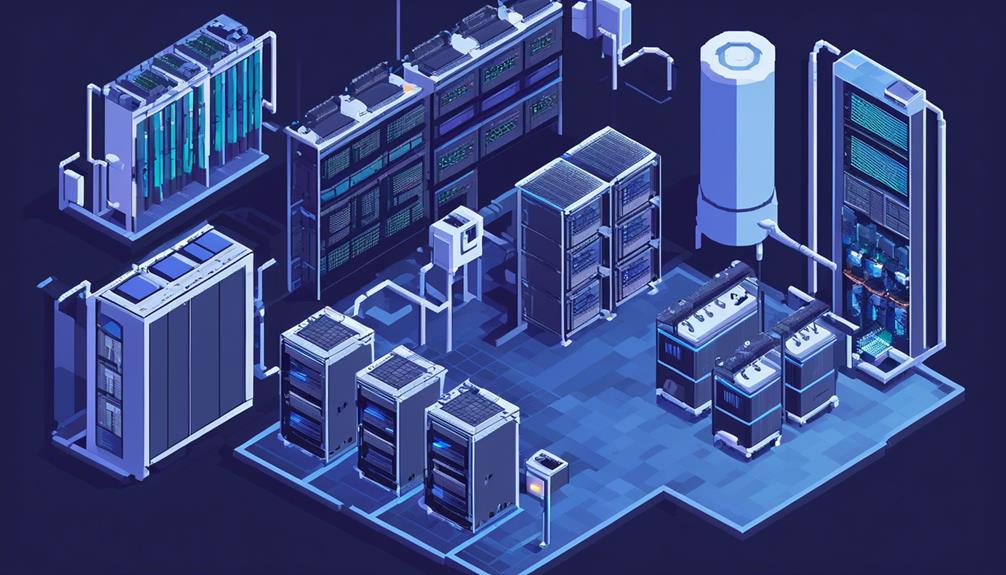
Adapting cooling solutions for AI data centers is essential to maintain optimal performance of high-density colocation configurations. With the increasing adoption of AI workloads powered by NVIDIA GPUs and high-speed InfiniBand interconnects, data centers must deploy specialized cooling systems to handle the power and cooling requirements of these technologies.
To highlight the importance of adapting cooling solutions for AI data centers, consider the following key points:
- Specialized Cooling Systems: AI workloads in data centers require high-performance cooling to optimize resource allocation and enhance data analysis and insights. Traditional cooling solutions may not be able to handle the heat generated by GPUs, which are essential for accelerating AI workloads. Therefore, data centers need to invest in specialized cooling systems that can efficiently dissipate the heat generated by these powerful processors.
- Predictive Analytics and AI Algorithms: By leveraging predictive analytics and AI algorithms, data centers can optimize their cooling systems. These technologies can monitor temperature fluctuations, predict cooling demands, and adjust cooling resources accordingly. This not only reduces costs but also improves energy efficiency, as cooling resources are allocated based on real-time requirements.
- Continuous Evolution and Improvement: As AI workloads continue to evolve and grow in complexity, data centers must continually adapt their cooling solutions to meet the increasing demands. Cooling technologies need to keep pace with the advancements in AI hardware and software, ensuring that data centers can effectively handle the heat generated by these technologies without compromising performance or reliability.
Frequently Asked Questions
How Is AI Used in Data Centers?
AI is used in data centers in various ways to enhance efficiency and performance.
AI powered predictive maintenance allows for proactive identification of potential equipment failures, minimizing downtime.
AI driven energy optimization optimizes energy consumption by analyzing usage patterns and adjusting power allocation accordingly.
AI based workload management ensures efficient allocation of resources to meet demand.
AI enabled security monitoring detects and responds to potential threats in real-time.
AI assisted resource allocation optimizes resource utilization by dynamically allocating resources based on workload requirements.
What Is the Introduction of AI in Data Analytics?
The introduction of AI in data analytics refers to the integration of artificial intelligence technologies into the process of analyzing and interpreting data. This involves the use of AI applications and algorithms to optimize data center operations, improve resource management, and enhance security.
AI advancements in data analytics enable the handling of large-scale data processing, support for complex machine learning algorithms, and facilitate the development and deployment of AI applications.
However, it also poses challenges such as data privacy and ethical concerns that need to be addressed.
What Is the Introduction of AI in Brief?
AI, or Artificial Intelligence, is a rapidly advancing field that involves the development of intelligent machines capable of performing tasks that typically require human intelligence. The introduction of AI has had a transformative impact on various industries, revolutionizing processes and improving results.
AI applications range from virtual assistants and chatbots to self-driving cars and predictive analytics. Its importance lies in its ability to automate tasks, enhance decision-making, and unlock valuable insights from vast amounts of data.
What Are the 4 Types of Ai?
The four types of AI are:
- Supervised AI: This type involves training models using labeled data for making predictions or decisions. By providing the AI system with labeled data, it learns to identify patterns and make accurate predictions based on the given examples.
- Unsupervised AI: In contrast to supervised AI, unsupervised AI trains models on unlabeled data. The goal here is to find hidden patterns or structures within the data without any specific guidance. This type of AI is often used in data clustering or anomaly detection.
- Semi-supervised AI: As the name suggests, semi-supervised AI combines labeled and unlabeled data. By using a small amount of labeled data and a large amount of unlabeled data, this type of AI can benefit from both supervised and unsupervised learning techniques. It leverages the labeled data to guide and refine the learning process.
- Reinforcement AI: Reinforcement AI learns through trial and error. It involves agents that interact with an environment and learn from their actions and the feedback they receive. Agents are rewarded or penalized based on the outcomes of their actions, encouraging them to learn and improve their decision-making abilities.
These types of AI have diverse applications and use cases in various industries. They showcase the advancements in AI technologies and algorithms, enabling machines to perform complex tasks and make intelligent decisions.
